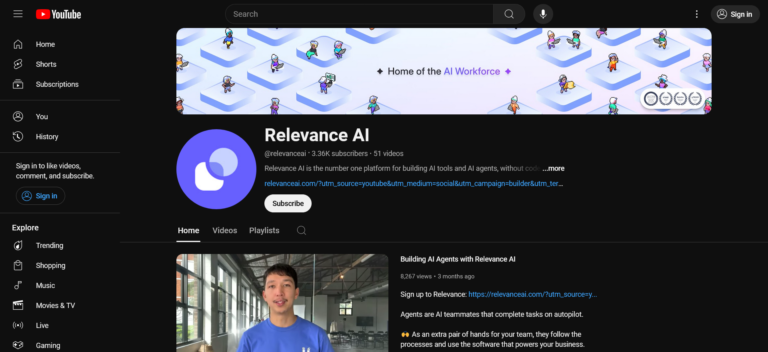Swarm by OpenAI: Revolutionizing AI with Multi-Agent Frameworks
Relevance.ai
Absolutely incredible! Relevance.ai’s Agents are a true game-changer for any team looking to automate workflows and enhance productivity. These AI teammates handle tasks on autopilot, becoming an extra pair of…
Key Take-aways
- Introduction of OpenAI’s Swarm: Swarm is an open-source framework designed to build multi-agent setups, featuring two main components: agent runtime and agent handoff, which enable more advanced task completion.
- Evolution of AI Agents: Unlike traditional AI models focused on text completion, agentic reasoning engines use AI models to decide which tools or functions to use for task completion.
- Collaboration Challenges in Multi-Agent Systems: Effective multi-agent systems require a collaborative approach, memory management, and seamless communication, making frameworks like Swarm valuable as educational tools but insufficient for production-ready applications.
In recent discussions, OpenAI’s Swarm has emerged as a promising new framework for building multi-agent systems. Dan from Relevance sat down with Jason, also known as AI Jason, to delve into the implications of Swarm for developers and AI enthusiasts. This article explores Swarm’s key features, its impact on multi-agent design, and how Relevance is navigating this evolving landscape.
Success Stories: Understanding OpenAI’s Swarm
OpenAI’s Swarm introduces a novel approach to AI development:
- Agent Runtime: This feature simplifies the creation of single autonomous agents. It allows developers to define tools and instructions, enabling agents to complete tasks without constant human input.
- Example: Developers can use Swarm’s runtime to build agents that autonomously handle processes like content creation, customer inquiries, and basic business operations.
- Agent Handoff: Swarm’s standout innovation is the ability to transfer tasks between agents seamlessly. Agents can pass context and previous chat history to other agents, enabling more efficient task delegation and communication.
- Example: An agent tasked with creating a blog post can pass the completed draft to another agent responsible for publishing it on a CMS, with the entire conversation history intact.
What is Swarm? Key Features of OpenAI’s New Framework
OpenAI’s Swarm is a groundbreaking tool for building AI systems capable of more than simple text generation. Here’s a breakdown of its essential features:
- Agent Runtime: A foundational component that enables the creation of autonomous agents, allowing them to complete tasks independently by leveraging AI’s reasoning abilities.
- Agent Handoff: Swarm’s innovative approach to communication between agents makes it easier to manage complex workflows, as agents can now pass full context and conversation history to other agents.
- Educational Focus: Swarm is currently intended for educational purposes, helping developers understand how to set up multi-agent systems rather than build production-ready applications.
Building Your Multi-Agent Framework: Best Practices from Relevance AI
Jason and Dan highlight key strategies for building effective multi-agent systems at Relevance AI:
- Complex Workflow Breakdown: To manage intricate business processes, multi-agent setups divide workflows into specialized agents, each responsible for a specific task.
- Effective Communication Management: Swarm’s agent handoff allows for smoother communication between agents, but memory management remains a challenge, especially when implementing production-level systems.
- Example from Relevance AI: Relevance AI has developed a sales agent system that effectively manages communication and memory between multiple agents, ensuring higher efficiency.
- Integration with Domain Experts: In multi-agent systems, domain experts play a vital role in guiding agents, ensuring the system aligns with real-world needs. Relevance AI’s sales agent, for example, required input from the sales team to refine messaging and automate tasks successfully.
Top Use Cases for Multi-Agent Frameworks
If you’re considering building a multi-agent system, selecting the right use case is crucial. Here are some promising niches:
- Customer Support Automation: Multi-agent systems can streamline customer support, using specialized agents for initial inquiries, escalation, and resolution.
- Content Creation Pipelines: With agents designated for research, drafting, editing, and publishing, content production can be more efficient.
- Data Analysis and Reporting: Multi-agent setups can break down complex data analysis tasks, ensuring accurate and timely reporting.
Starting with clear, focused use cases can help developers leverage Swarm’s framework effectively while scaling up as they gain experience.
Analyzing OpenAI’s Swarm for Multi-Agent Design
While Swarm introduces valuable components for multi-agent development, certain challenges must be addressed:
- Complexity in Communication: While Swarm’s handoff feature is useful, managing the transfer of context between agents can be resource-intensive.
- Memory Management: Effective memory sharing across agents is critical. Swarm currently allows for context sharing, but optimizing this for production use requires more sophisticated memory management solutions.
- Collaborative Workflows: Developers need to implement more advanced mechanisms, like group chat capabilities or step-by-step task handling, to ensure agents collaborate seamlessly.
By addressing these challenges, developers can use Swarm as a foundation to build more advanced, production-ready multi-agent systems.
Monetization Methods for Multi-Agent Frameworks
For developers and companies looking to monetize multi-agent systems, there are several strategies:
- Software as a Service (SaaS): Offer multi-agent systems as a subscription-based service, providing regular updates, support, and new features.
- Consulting Services: Help businesses implement customized multi-agent frameworks tailored to their specific workflows and challenges.
- Educational Courses: With frameworks like Swarm geared toward education, developers can create courses that teach others how to build, deploy, and manage multi-agent systems effectively.
Is OpenAI’s Swarm Right for Your AI Project?
Swarm is an exciting step forward in the world of multi-agent systems, offering developers a playground to experiment with agentic reasoning and task delegation. While Swarm is not yet suitable for production-ready applications, its educational value is undeniable.
For developers, AI engineers, and businesses exploring agentic workflows, Swarm provides a unique opportunity to understand the complexities of multi-agent systems without the pressure of immediate production use. By experimenting with Swarm, you can learn how to design and orchestrate agents that collaborate effectively, paving the way for more robust applications.
Relevance AI, with its deep expertise in multi-agent development, continues to refine its own systems while leveraging new tools like Swarm to educate and inspire the next generation of AI developers.
Ready to dive into multi-agent systems? Explore OpenAI’s Swarm today, and discover how agentic reasoning can transform your AI projects.

